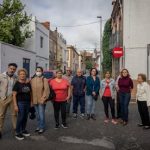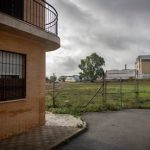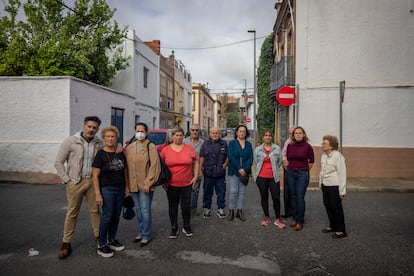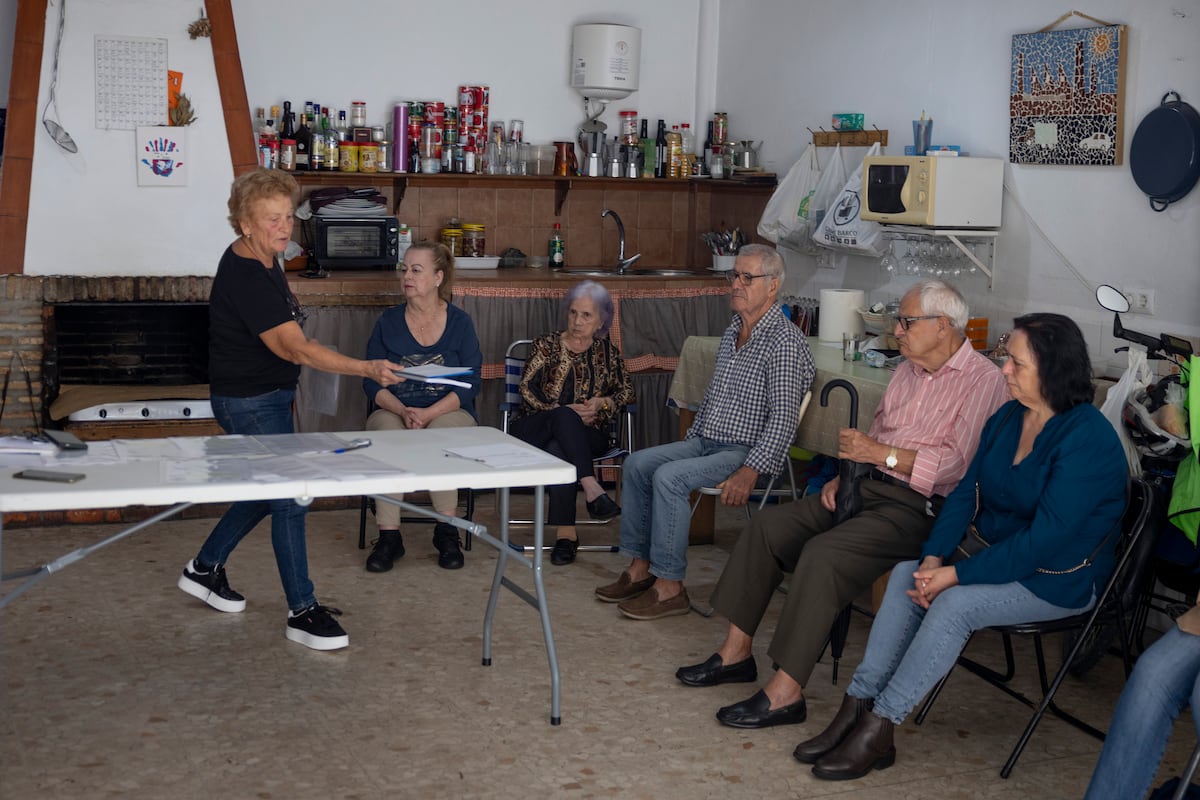

Abandonment, frustration, despair, helplessness and anger. This is the amalgamation of sensations with which the 4,000 residents of the Guadalquivir neighborhood of Coria del Río (Seville, 30,919 inhabitants) have become accustomed to living since seven years ago they began their fight to end the pollution that had been emanating from the soil for decades. that surround it and whose toxic gases are making the majority sick. Because what it has been impossible for them to get used to is constantly living with the stench of fuel that infiltrates their bodies and permeates the walls of their houses, making the air around them unbreathable.
“How can they let us live like this?” asks Rogelia Gómez, president of the Association of Neighbors Affected by Toxics of Coria del Río, indignantly. In the garage of his house, which serves as the headquarters of the entity, from time to time a smell of oil sneaks in and after a few minutes it catches in the throat. With that question, Rogelia summarizes the apathy of the administrations – from the City Council to the Ministries of Environment and Health and Parliament, in recent months – to remedy a pollution problem documented by the Nature Protection Service ( Seprona), the National Institute of Toxicology and the Environment Agency of the Government of Andalusia and recognized by the Superior Court of Justice of Andalusia. However, after almost a decade since they filed a complaint with the Environmental Prosecutor’s Office to investigate the origin of the toxic gases and almost a year after the TSJA itself urged the Corian council to declare contaminated soil in the area surrounding the neighborhood, everything remains the same. Or not. It’s gotten worse. The health problems derived from the constant inhalation of hydrocarbons, evidenced by dizziness, headaches, tumors, leukemias and heart problems, worsen. “We are in total abandonment,” Rogelia laments.
In 2018, after a year of presenting complaints to the City Council and leading a massive march to draw attention to the unbearable smell of gasoline that they had been breathing for years, the Prosecutor’s Office ordered the Civil Guard to investigate the origin. Seprona confirmed the existence of a hydrocarbon spill from a nearby gas station, owned by Zamarrilla Inversiones, due to leaks in one of the gasoline tanks. He also detected the existence of cracks in the wastewater collector as it passed through the service station. The Civil Guard carried out studies in some neighbors’ houses, where the presence of volatile organic compounds derived from hydrocarbons was confirmed, as well as dimethyl sulfate, a substance that is very toxic by inhalation. Eight residents of the neighborhood, including two children, underwent analyzes carried out by the National Institute of Toxicology that showed the presence of different chemical compounds. Their document warns that “the concentration of benzene in the neighborhood exceeded the maximum allowed by law by 16 times, given its impact on human health.”
The Seprona report, which has later been corroborated by other studies by Ecologistas en Acción and the Environment and Water Agency, concludes that the hydrocarbon leaks produced substantial damage to the quality of the soil and risk to the health of the neighbors. , given the atmospheric pollution that is linked to the sewage network and the persistence of exposure to the toxic.” “The determining factor here is not the risk of the estuary, but the brutal impact on the health of the neighbors,” emphasizes Isidoro Albarreal, a member of Ecologistas en Acción, who is also involved in the criminal case.
Toxic substances with “extremely harmful” consequences in the blood

And the constant exposure to the more than 10 chemical compounds that were identified in the measurements carried out by the technicians, among them benzene, toluene, dimethyl sulfate or hexane, with “extremely harmful” consequences and in some cases with levels “intolerable” risk conditions, according to reports, are undermining the health of the neighborhood’s residents. “There are very few neighbors who do not suffer from nervous disorders, muscle problems, headaches, feelings of lack of air, insomnia, loss of consciousness…” explains Sergio González, 51, the first resident of the neighborhood to obtain disability. recognized by toxic inhalation.
138 residents who had conditions related to the inhalation of toxic gases managed to be treated exclusively by the Internal Medicine department of Virgen del Rocío. The Ministry of Health committed to carrying out an epidemiological study to analyze the symptoms and effects of this exposure. Those affected have demanded this report, but the hospital maintains that it wrote it in 2022 and that it cannot provide it to you because the procedure is judicialized. Nor is it in the power of the judge investigating the case, who on January 22 referred it to the General Directorate of Public Health, without having forwarded it to date. “We have had no response since then,” says Rogelia with resignation. The neighbors have done their own study of streets and there is not one in which there are no cases of heart attack or heart problems, cancer diagnoses, diseases compatible with volatile organic compounds.
And the delay in having this report is one more of the endless delays and obstacles of a criminal procedure, the investigation of which is still ongoing. The Provincial Court “in error” filed the case last June, but the case was reopened this Wednesday. In addition to the epidemiological study, the judge has been waiting since January 21, 2023 for a senior technician from the Madrid Environmental Prosecutor’s Office to inspect the cesspools that are found under the warehouses surrounding the neighborhood and on which have built homes, to confirm if they could constitute a second source of contamination.
Black wells, another possible source

“It is not a hypothesis, it is a reality,” says Pedro Guerrero, the municipal technician who in 2017 prepared a report on these cesspools and the lack of an adequate sanitation network and who linked them to odors, but which the City Council rejected. . “There was an industrial estate there and in the 90s the companies installed there were forced to have blind wells to collect their discharges without any treatment.” Precisely, eight months ago the Parliament of Andalusia unanimously approved a non-legal proposal to study the possible source of contamination from cesspools, but since then the working group has not met. “The fact that it has not been established means that work is not being done,” the Minister of the Environment, Catalina García, justified this Tuesday when asked about this delay.
Parallel to the criminal process, the Administrative Litigation Chamber of the TSJA ordered the Coria City Council in November 2023 to reactivate the declaration of the area as polluting soil, which it filed in 2021. A request that was reiterated on May 21, although the council argued which had already been fulfilled a month before. Added to the TSJA order is a report dated August 6 from the Environment and Water Agency of Andalusia, which warns that the floors of the gas station “continue to support unacceptable levels of contamination, well above the limits.” fixed”, despite the cleaning tasks that the company that owns the gas station has been carrying out voluntarily over the last 30 months. The Board entity also warns that the company is not carrying out follow-up controls adequately nor has it correctly delimited the perimeter of the land affected by contamination.
The neighbors do not understand the passivity of the City Council or the mayor’s interest in minimizing the consequences of permanently inhaling toxic gases. “I’m not saying that they are inventing anything, but they may be confusing odors,” said the mayor, Modesto González, after learning of the TSJA ruling, who also then considered a decontamination “done” that the report from this month of August refutes. “There is a very strong interest here in this not coming to light,” says Rogelia, pointing directly to the councilor, but also to Emasesa. The City Council has declined to make statements about the contaminated soils because it is an issue that is being prosecuted.
The affected neighbors also feel abandoned by the Ministry of Health, which refuses to give them the epidemiological report and their feeling of helplessness has increased this week with the lack of a concrete response from the Minister of the Environment regarding compliance with the NLP. . “Neither the sentence is complied with, nor the commitments that are created with us in health matters… we do not matter,” says Sergio. But above the incomprehension of the apathy of the administrations, what prevails in them is the fear of the future due to the deterioration in their health and the consequences that the children, about a thousand in the neighborhood, already have.
“We are not motivated by anything other than health,” emphasizes Rogelia. Silvia’s children are the two minors who underwent toxicology tests in 2017 with positive results for chemicals. “Fainting has been common since my daughter turned nine years old, and now she is 16. Of the two months of the course we have been in, she has already missed more than two weeks due to respiratory problems and headaches,” he explains: “The doctor attributes it to inhalation of toxins, but he does not leave it in writing.”
The person who does have a medical report proving that the nephrocalcinosis suffered by her 14-month-old son is due to “benzene poisoning during pregnancy” is Nuria Vargas. She became pregnant while living in Coria and after seven months she moved to the Canary Islands, where her baby was born. “After 27 days they had to admit him and after many tests, when I told the pediatrician what was happening in the neighborhood, he confirmed that the toxins to which we had been exposed during pregnancy affect the fetus,” he explains.
“They want to poison us, they want to let us die,” says Rogelia, who, like her neighbors, has become accustomed to not being able to sleep for more than an hour at a time because she chokes on the air she breathes. However, he does not resign: “We are going to continue until the end, they cannot let us live like this.”
